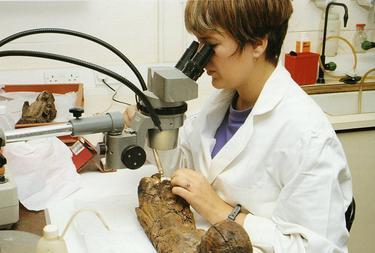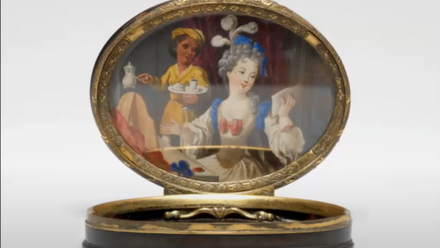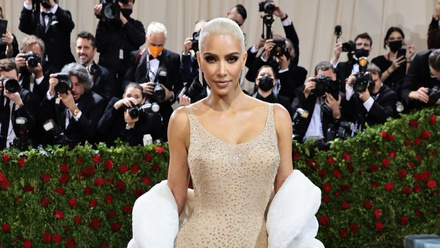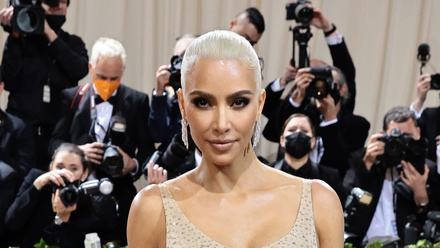Jane Henderson ACR, David Hopes, and Robert Waller explain the importance of well-informed and well-chosen management strategies that are needed to ensure that experiencing, caring for, and benefiting from heritage are all represented in heritage management decisions.
Header image: The outer staircase, Newhailes House. The control of the corrosion of iron railings has been a conservation challenge for NTS since 1997 both technically and in terms of communicating why they appear that way to the public. They epitomise the different biases that need to be negotiated in achieving a sustainable ‘macro focus’. Image courtesy of the National Trust for Scotland.
Conservators love microscopes; it’s often how we engage with our objects. It is through the microscope that we experience the intimacy with things that we so value in our work. The magnification helps us to exercise the control that can appear miraculous from the outside as we manipulate tiny details to enable objects to reveal themselves.

We mention microscopes because they help the user to focus on the smallest detail of a surface. The downside of this world view is that, if examined in close focus, most interactions with objects lead to change that feels like damage. This has led to a tenacious, but in our view unwarranted, concept that conservation (caring for things) conflicts with using them.
It is easy to understand this view. Over the last few months many families may have used their best china or glassware for a special meal: washing up the plates and wrapping them carefully afterwards, before putting them back into storage for their protection. But, the conflict between keeping and using only exists if you hold a very close focus. Of course, wrapping up and storing your best china is safer than taking it to a toddler’s birthday party, but if you wrap it and place it in the loft for years on end then it ceases to be the best of anything. Over time it is abandoned, disposed of, or at best taken to a second-hand shop for another family to re-imbue it with value.
As conservators it is our job to examine all the tiny changes that happen to heritage and consider their impact: to measure the effect of light landing on curtains, to monitor the corrosion of railings and to offer advice on how to manage those changes. It is a specialist task and one most of us are passionate about. Sometimes we care so much so that it can generate conflict with colleagues with other responsibilities in a heritage organisation. We have considered the impact of psychological biases on a conservator’s world view in Effective Preservation Decision Strategies.
If we changed the world from ‘bias’ to ‘perspective’ it makes things simpler. I have my perspective, you have yours.Lots of well documented evidence shows that factors like ‘availability bias’ encourage us to focus on the things we experience most directly and vividly. Used in psychology the word ‘bias’ has negative connotations, which we think make it harder for all of us to acknowledge the impact such biases have on our decisions. If we changed the world from ‘bias’ to ‘perspective’ it makes things simpler. I have my perspective, you have yours. It is easier to respect other people’s perspectives if you label them as such: the conservator’s concern with unnecessary damage, the educator’s focus on delivering learning experiences, the marketing team’s desire to engage new audiences for the heritage site.
Each perspective and preoccupation is vital to managing the value to society of heritage properties. It’s a mistake to believe ours is the only perspective, but equally it’s a mistake to attempt to bring a team or a community together without acknowledging multiple perspectives, without having confidence that the plurality of value systems better serves society than any single value system, even if that single system is our own. Sadly, a singular world view has been a curse of a heritage elite attempting to define the experience of the past through their own monocultural world view.
Like the best china, if it is broken it cannot be used to mark a family celebration but if it is never used it loses the potency of association...Standing back and respecting multiple approaches and perspectives has been a hallmark of engaged heritage management in recent years. Even where this might feel challenging, a macro focus reveals a bigger and more fulfilling picture. The value of heritage is realised by the combined work of the educator, the marketing professional, the curator, and the conservator. As we said in Begin with Benefits: Reducing Bias in Conservation Decision-Making:
“A building which has no visitor income has no conservation budget, an interior that is not experienced is not valued and a sense of place requires people to connect. Without the financial and emotional value of connection, a building will have no future, negating all preservation goals.”
Equally the marketing team can be the very best but if the heritage is not interpreted by the combined efforts of the conservators, curators, and educators they cannot make fully meaningful connections. Conservators must grasp this challenge and ensure that conservation goals contribute toward the mission of the organisation.
The goal for all of us charged with responsibility for the heritage is to ensure that experiencing, caring for, and benefiting from heritage are all represented in heritage management decisions with a view to offering well-informed and well-chosen management strategies. Like the best china, if it is broken it cannot be used to mark a family celebration but if it is never used it loses the potency of association: the true value of heritage is only realised if every aspect works together.
- Jane Henderson ACR is Professor of Conservation at Cardiff University and Secretary General of IIC.
- Dr David Hopes is Head of Collections & Interiors (Policy) at the National Trust for Scotland.
- Dr Robert Waller is President and Senior Risk Analyst at Protect Heritage Corp. He is also Adjunct Assistant Professor at Queen’s University and a Research Associate at the Canadian Museum of Nature.
References:
- Henderson, J. and Waller, R. 2016. Effective preservation decision strategies. Studies in Conservation 61(6), pp. 308-323. https://doi.org/10.1179/2047058415Y.0000000019
- Henderson, J., Waller, R. and Hopes, D. 2020. Begin with benefits: reducing bias in conservation decision-making. Studies in Conservation 65(S1), pp. 142-147. https://doi.org/10.1080/00393630.2020.1787638





